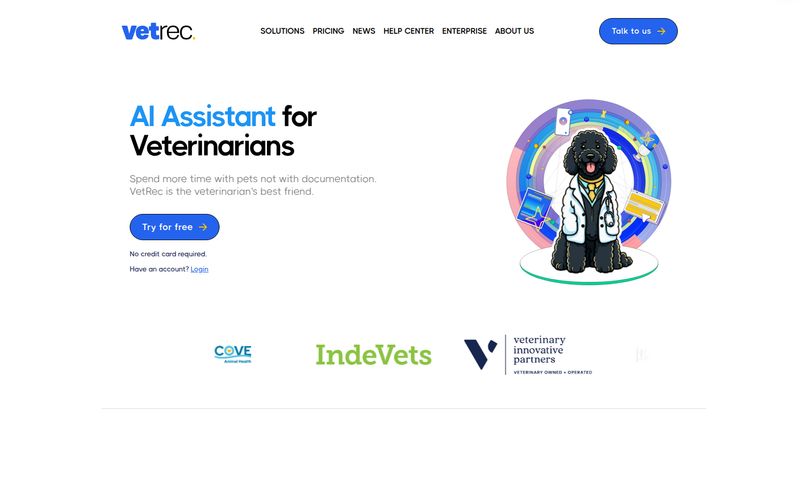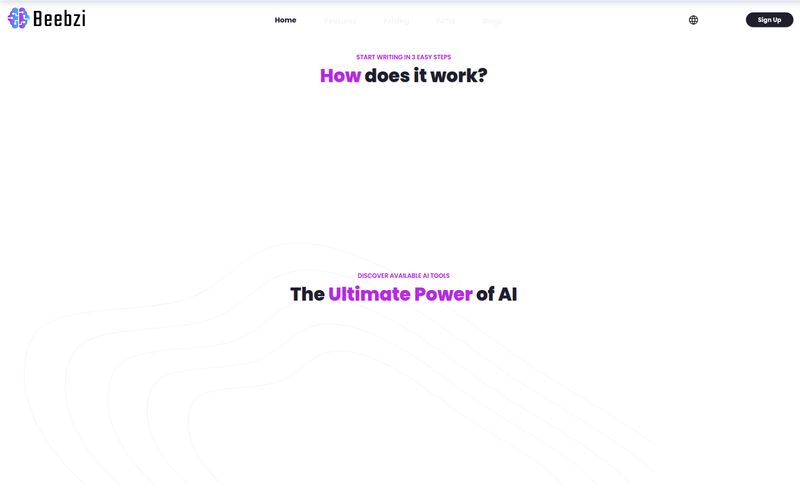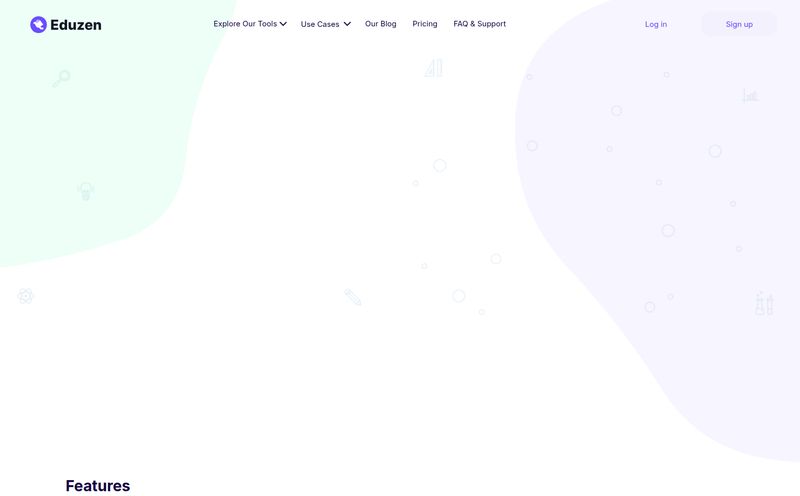The content hamster wheel is exhausting. As someone who lives and breathes SEO and content, I feel it in my bones. You have to be consistent. You have to be authentic. You have to pump out high-value thought leadership on LinkedIn, write insightful blog posts, and script engaging videos. All while, you know, actually running a business or doing your job.
It’s a tall order. Many of us turn to AI writers to lighten the load, but then the content comes out… a bit bland. A bit robotic. It lacks that spark, that genuine you that actually connects with an audience. It's like serving a guest a meal you bought from the frozen aisle—it fills the plate, but nobody's asking for the recipe.
So when I stumbled upon a tool called Saystory, my curiosity was definitely piqued. It claims to be a “voice-to-AI platform” designed to turn your spoken thoughts into authentic content. Not just transcribing, but analyzing your tone to create something that actually sounds like you. Could this be it? The bridge between AI efficiency and human authenticity? I had to find out.

Visit saystory
So, What is Saystory, Really?
At its heart, Saystory is a content creation platform that starts with your voice. You record yourself talking—rambling about an idea, explaining a concept, reacting to industry news, whatever is on your mind. Then, its AI takes that recording, transcribes it, and, here's the magic part, analyzes your tone of voice to craft a first draft of a piece of content. Think blog post, LinkedIn update, video script, you name it.
It’s designed for the people who are often the face of the company: founders, marketers, consultants, and creators. The people who have brilliant ideas but are perpetually short on time. It's like having a personal ghostwriter in your pocket, one that has been trained on your unique way of speaking. Forget staring at a blinking cursor. Just talk, and the content follows.
Your Voice is Your Most Underrated Content Asset
For years, we’ve been told that to build a personal brand, we need to “find our voice.” It’s become such a cliché. But it’s a cliché because it’s true. People don't connect with logos; they connect with other people. Your unique perspective, your quirks, your passion—that’s what builds trust and authority.
The problem is, translating that spoken voice into written text is incredibly difficult. When you write, you filter yourself. You edit. You try to sound “professional.” You lose the raw energy of the original idea. Saystory seems to be built on this exact premise. It captures the idea before you have a chance to sanitize it. In my experience, the best content always comes from a place of genuine excitement or frustration, and that's something that's way easier to speak than to type.
A Look at the Key Saystory Features
Okay, let's get into the nuts and bolts. What does this thing actually do? It's more than just a fancy voice recorder.
From Voice Memo to Viral-Worthy Post
The core workflow is beautifully simple. You hit record in the app and just talk. Timothy Varghese, a Growth Marketer who uses the tool, mentioned how it helps turn his “rambling and unstructured thoughts into coherent pieces of content.” I feel that. My best ideas often come out as a jumbled mess. The ability to just brain-dump and have an AI clean it up into a structured first draft is a massive time-saver. We’re not talking about a perfect final copy, but getting that first 80% done is often the hardest part.
More Than Words: Tone of Voice Analysis
This is the feature that I think separates Saystory from the pack. It’s not just transcribing your words and feeding them to a generic AI model. It claims to analyze the nuances of your speech—your pace, your emphasis, your pauses—to better capture your authentic style. Is your tone educational, passionate, or maybe a bit sarcastic? The AI tries to reflect that in the written output. This is a huge step toward solving the “robotic AI” problem. It’s an attempt to bottle the lightning of your spoken ideas.
Teamwork and Ghostwriting Made Easy
Saystory also seems to understand that content is often a team sport. It has collaboration features built in, which is a godsend for agencies and internal marketing teams. I was particularly struck by the testimonial from Philippa Main, a B2B ghostwriter. She uses it to capture her clients' voices without spending hours on interview calls. The client can just send a few voice notes, and she gets a draft that already sounds like them. That's not just a time-saver; it’s a better way to deliver the core service of ghostwriting—authenticity.
Let's Talk Money: Saystory Pricing Plans
Alright, the all-important question: what’s the investment? Saystory offers a few different tiers, which seems pretty standard for a SaaS platform. Here's how it breaks down.
- Individual Rose: For $50 per month, you get one seat, a generous 100,000-word limit, and up to 200 voice inputs with a 2-minute limit each. This plan includes all the core features like brand voice analysis, AI briefs, and multi-language support. Honestly, for a solo founder or a creator looking to seriously up their content game, this feels like a very reasonable price point. Think of the hours saved.
- Comms Orchid: Priced at $80 per month, this plan is for small teams. It bumps you up to 2+ seats, a 300,000-word limit, and 500+ voice inputs with a 3-minute limit. If you're a marketing manager with a small team or an agency managing a few clients, this is likely the sweet spot.
- Enterprise Sunflower: This is the classic “get in touch for custom pricing” plan. It’s tailored for larger organizations that need more seats, more security, and potentially some bespoke features. Standard stuff for enterprise-level software.
Overall, the pricing seems fair for the problem it solves. If it saves you even 5-10 hours a month on drafting content (which seems plausible), it easily pays for itself.
The Good, The Not-So-Good, and The AI
No tool is perfect, right? It’s important to have a balanced view. From my analysis and looking at what it does, here’s my take.
On the plus side, the time-saving potential is obvious. It dramatically simplifies the process of getting ideas out of your head and onto the page. The focus on authenticity through voice is a massive pro in a sea of generic AI tools. And for teams, the collaborative aspect is a clear win.
On the flip side, you have to be mindful of becoming too reliant on it. The quality of the output is always going to depend on the quality of your input. If your voice note is vague and lacks energy, the AI can only do so much. There’s also the risk that the AI, while good, might occasionally miss the nuance you were going for. That's why I see it as a “first draft” machine, not a “final copy” machine. You'll still need that human touch to polish and perfect the final piece, but that's a much smaller task than starting from zero.
Frequently Asked Questions About Saystory
1. How is Saystory different from just using Otter.ai and ChatGPT?
That's a great question. While you could cobble together a similar workflow, the main difference is integration and intelligence. Saystory combines transcription, tone analysis, and content generation into one seamless process. The key is the “tone analysis,” which aims to produce content that mirrors your speaking style, something you don't get by just pasting a raw transcript into ChatGPT.
2. Can it handle different languages and accents?
Yes, the platform supports multiple languages. While every transcription service has its challenges with very heavy accents, modern AI has gotten remarkably good at it. The goal is to capture the essence of what you're saying, and it seems well-equipped to handle a variety of speakers.
3. What if I ramble a lot in my voice notes?
That’s kind of the point! It's designed for that. The AI's job is to find the signal in the noise. It sifts through your unstructured thoughts, identifies the core message, and builds a coherent draft from it. So ramble away—it's part of the creative process it's built to support.
4. Who is the ideal user for Saystory?
The ideal user is a busy professional who needs to create authentic, thought-leadership-style content consistently. This includes founders, C-level executives, marketing managers, consultants, and content creators. If your ideas are your currency, but time is your bottleneck, this tool is likely for you.
5. Is the generated content SEO-friendly?
The content it generates is a first draft. For it to be truly SEO-friendly, you'll still need to apply your SEO knowledge. This means refining keywords, structuring with proper headings (like in this article!), adding links, and ensuring it fully answers user intent. Saystory gives you the raw clay; it's still your job to sculpt it into an SEO masterpiece.
My Final Thoughts on Saystory
So, is Saystory the magic bullet for all your content woes? Probably not. No tool is. But is it a powerful ally in the fight against the blank page and robotic content? Absolutely.
I see its real value as an idea-capture and first-draft machine. It closes the gap between a fleeting thought and a tangible piece of content. For busy founders and marketers who want to build their brand without sacrificing their soul (or their entire weekend), it feels like a genuinely innovative solution. It brings the focus back to the most valuable part of content creation: the idea itself. And by using your voice, it keeps the most important ingredient—you—at the center of it all.



